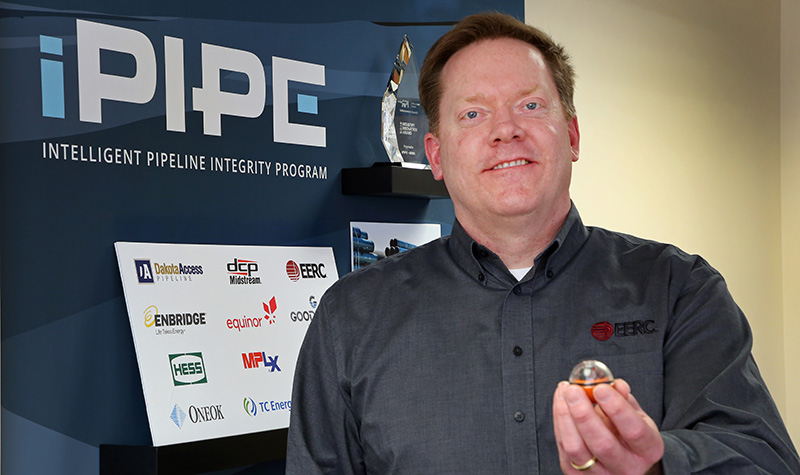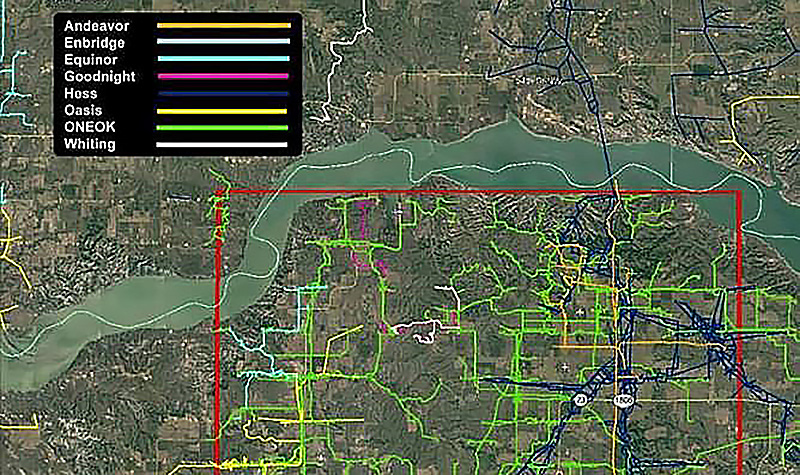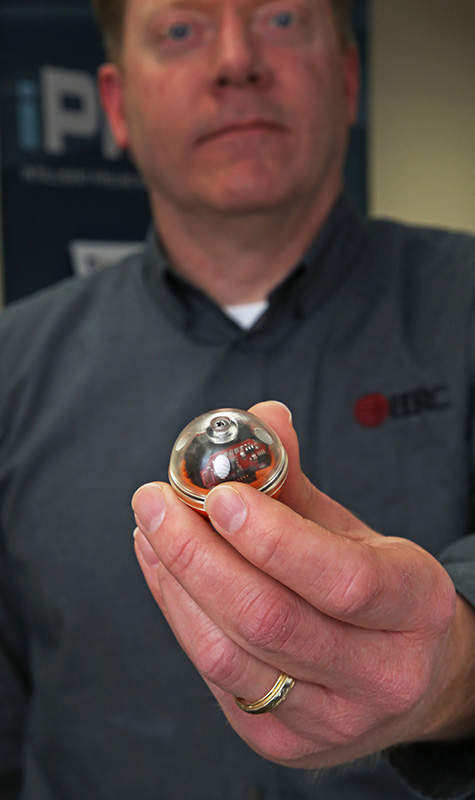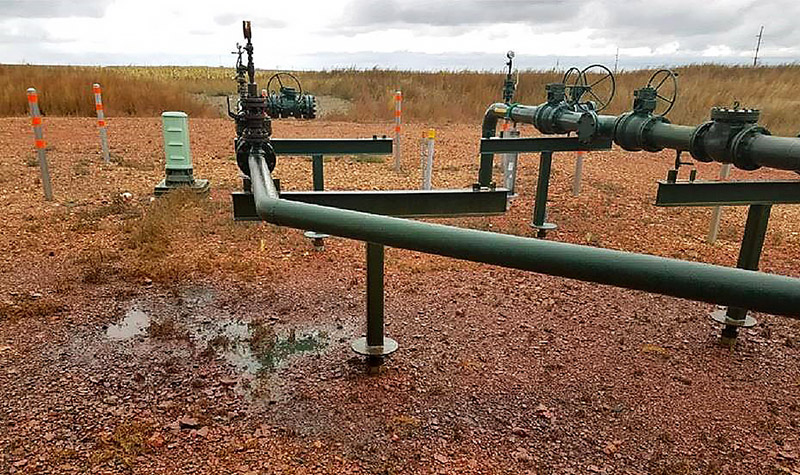13 Mar UND EERC assisting onn the path to zero pipeline spills
EERC’s iPIPE program adds two new key members and tests new technologies

The UND Energy & Environmental Research Center’s iPIPE program is meeting with success in developing technologies and attracting new members. Jay Almlie, shown holding the INGU Solutions Pipers leak detection device, is the iPIPE project manager. Photo by Patrick C. Miller/UND Today.
“Nothing succeeds like success,” said famous 19th century French author Alexandre Dumas.
Although Dumas wasn’t thinking of technologies to prevent pipeline spills, his idea applies to the UND Energy & Environmental Research Center’s (EERC) Intelligent Pipeline Integrity Program (iPIPE). The growing success of the industry-led consortium has seen it attract new members and add new technologies to the toolboxes of companies seeking ways to detect and prevent pipeline spills.
“Our mantra within iPIPE is that a high tide floats all boats,” said Jay Almlie, iPIPE program manager and EERC principal engineer. “How do you get a high tide? You get a lot of water surging. In our case, water is membership. As you get more members, you’re able to create a higher tide.”
iPIPE recently grew to 12 participants with the addition of two major players in the oil and gas pipeline industry – Dakota Access Pipeline, a subsidiary of Dallas-based Energy Transfer LP, and TC Energy, (formerly TransCanada) headquartered in Calgary, Alberta.

Satelytics, a company that analyzes satellite images to detect leaks of oil and brine from pipelines, is entering its third round of development under iPIPE. The technology uses machine learning and artificial intelligence to continuously improve its ability to detect leaks. This image shows pipelines of iPIPE members operated in North Dakota’s Bakken oil fields being monitored by Satelytics. Photo courtesy of EERC.
“Dakota Access Pipeline is excited to help steer the efforts of this program, and expects that the outcomes will result in an even greater record of safe operations across the entire pipeline industry,” said Vicki Granado, vice president of corporate communications for Energy Transfer, the operator of the Dakota Access Pipeline.
“TC Energy is committed to operating the safest asset base in North America, using technology and advanced analytics to achieve that goal,” said Leslie Kass, executive vice president, Technical Center for TC Energy.
Pipelines in the news
Dakota Access Pipeline has been in the news again after receiving approval from the North Dakota Public Service Commission to double the capacity of its pipeline transporting crude oil from the Bakken oil fields in western North Dakota to a terminal in Illinois. TC Energy plans to build the Keystone XL Pipeline to carry Canadian crude from Hardisty, Alb., to a terminal in Steele City, Neb. Other pipelines will then transport the oil to U.S. refineries along the Gulf Coast.
In addition, iPIPE’s members are supporting development of Direct-C, a company in Edmonton, Alb., producing pipeline coatings that act as sensors to detect leaks. iPIPE members with operations in the prolific Permian shale formation of New Mexico and Texas are also testing technologies in the region.
According to Almlie, the program’s success has helped it attract new members and new technologies, and the program is poised for further expansion.
“What participants like is the collaborative nature of the program,” Almlie explained. “What they’re hearing from their peers in industry is that within this program, members have found a forum where they can share successes and failures — what’s worked and what hasn’t worked. They don’t all have to relearn the same lesson.”
And, Almlie continued, “They like that we’re developing these technologies, putting new tools in their tool belt, and everyone shares the cost. No one company has to be the guinea pig.”

When North Dakota Gov. Doug Burgum presented the 2020 State of the State Address on UND’s campus Jan. 29, he discussed the success of the EERC’s iPIPE program, which began as a 2017 initiative under his administration to reach a goal of zero pipeline spills in the state. Photo by Shawna Schill/UND Today.
Gov. Burgum’s pipeline initiative
The partnership between the EERC and pipeline companies began in 2017 under an initiative launched by North Dakota Gov. Doug Burgum, who set a goal of zero pipeline spills within the state. Between the progress made and the success of technologies developed under iPIPE, Almlie believes the organization’s membership could double over the next one or two years.
“When you get that many collaborators working together, you’re going to change the way the industry does business,” he said. “I’m very excited by the potential of other states to participate in iPIPE, much as the North Dakota Industrial Commission has participated with cost-match funding. Gov. Burgum is helping to change the way pipelines are monitored. His mantra is applying technology and innovation, not regulation.”
Almlie took time to visit with UND Today about the outlook for iPIPE and the technologies its members are developing. The following Q&A has been lightly edited for clarity.
How does iPIPE select which technologies to develop?
We’ve been through three technology selection events. Some have labeled them ‘shark tanks’ because of the similarity to the popular ABC TV show, Shark Tank. We’ll bring promising new technologies before a committee with one representative of each member company. The experts hear the presentations and they choose which ones they want to fund and help co-develop. From that process, the committee has offered eight different projects to date.
iPIPE offers a co-development opportunity. We will give them cash funding to help them develop their product. We’ll also give them live operating pipelines upon which they can develop their product. There’s no better sandbox than an actual operating environment. We’ll provide them with feedback constantly throughout the development process. We’re partners in development with them, and we help them refine the product as they go along through the process. It’s been tremendously valuable to the technology providers and to our members, the pipeline operators.

Almlie shows the golf ball-sized Pipers device from INGU Solutions that’s packed with sensors to detect potential leaks from inside an oil industry pipeline. Photo by Patrick C. Miller/UND Today.
What technology successes have helped iPIPE attract new members?
Our first two technologies have been very successful. One is from a company called Satelytics. What they do is buy huge quantities of data from satellites overlooking the Bakken and Permian basins. They process all those pixels using machine-learning algorithms, looking for hydrocarbon leak signatures or brine leak signatures. With machine learning, the machine gets smarter the more data you feed it. We’ve been feeding them a lot of data. We’ve been giving them feedback on what’s a correct identification and what’s not. The algorithms are getting better at what they do. Some iPIPE members are considering commercial contracts with Satelytics because they believe it can do what we set out to do.
Another example of success is from a company called INGU Solutions, which makes golf-ball sized devices called Pipers. They pack each Piper with instruments to monitor temperature, pressure and magnetic sensing. It uses the magnetic memory method to detect changes in the pipe wall as it passes through the pipe. It won’t do absolute measurements, but it’ll tell if it’s seeing signs of corrosion or potential weakening at a welded joint. But most importantly to us, it has microphones. As Pipers flows through the pipeline, it’s listening for leaks. If it’s a pressurized pipeline with liquid or gas – as this ball flows through the pipeline – it’ll hear the hiss as something that’s been pushed outside through a crack in the pipeline.
We measure success by the fact that INGU completed a scientifically designed test program. They learned some new functions that Pipers can do. Two of our members are now contracting with them for commercial services. They took off commercially. It’s a new tool in what was an empty slot in the tool belt.
Why is it important to monitor pipelines for brine leaks? Aren’t oil leaks the biggest problem?
Brine is the produced water from oil wells. For every barrel of oil we produce, we produce at least a barrel of brine from the formation. It’s very salty water, and we have to dispose of the produced water. Pipelines carry a lot of it to underground formations for storage. In many respects, a brine spill is worse than an oil spill. Brine spills are really our No. 1 focus. If you spill brine on the ground, it’s a decade or more of spoiled earth. Nothing will grow there. If you spill oil on the ground, a year later, green grass will grow because microbes break down the hydrocarbon and turn it into fertilizer.
What other technologies are being developed through iPIPE that will help pipeline operators prevent spills and leaks?
We’re working on one right now that we hope will successful. It’s a company called Direct-C, and they have a polymer nanocomposite film that basically acts as a sensor. When the film gets wet – either from oil or brine – the nanocomposite material within the film aligns itself and it changes the electrical resistivity. It’ll set off an alarm saying, ‘Hey, I feel wet!’ We can then tell whether the pipeline has leaked or not. We’re running tests through the winter months to see how it fares in our harsh winter.

Spills from pipelines carrying brine or produced water from oil and gas drilling operations can cause more damage to land than spills from oil pipelines. Preventing brine spills is iPIPE’s No. 1 focus. Photo courtesy EERC.
Would the film have to run the entire length of a pipeline?
The concept comes in a few different flavors. They can have a bunch of small sensors painted on a substrate strung along the pipeline. A fencepost arrangement is sunk into the ground right next to the pipeline every 50 feet in high-consequence areas. Heads on the fence posts communicate with each other, like an Internet of Things approach. It’s similar to how smart devices in our home are now creating their own virtual network by talking to each other – not to the outside world. We can form a net around the very high-consequence areas of the pipeline.
Another Direct-C flavor is called WrapSense. It’s a sheet wrapped around flanges, joints, weld seams and valves – places where it’s more likely pipelines will leak. Using WrapSense, we can detect when a joint is leaking. The third Direct-C flavor is FiberSense, a fiberoptic cable painted with a coating. This provides continuous measurement. For example, if you wanted to run a pipeline under Lake Sakakawea in North Dakota, you might lay FiberSense with the pipeline, and it could tell you down to the centimeter (.39 of an inch) exactly where you have a problem. It might run for a mile across Lake Sakakawea. We don’t have any results on this one yet, but it’s being tested in the field right now. It’s installed in 26 different locations in western North Dakota, and we’re watching it through April.
What other technologies are on the horizon for iPIPE?
We selected Satelytics for a third phase of development. We want to see if their technology can see through snow, and we’ve had a lot of it this year. We also want to see what it can do for looking at methane gas leaks instead of just liquid leaks. That’s an area of growing interest for pipeline operators. We’ve started monitoring for this every week over North Dakota and New Mexico.
Another one that we’re close to contracting with is a company called Orbital Sidekick. They’re going to launch a hyperspectral sensor onboard the Aurora satellite. That sensor will able to tell us more advanced things, in theory, about certain kinds of leaks. We want to see what advantages hyperspectral sensors offer on an orbiting satellite. Orbital Sidekick has other customers with different sensors on their satellite, which is supposed to launch in March.


